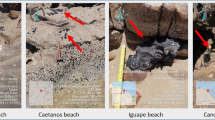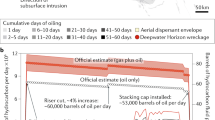Abstract
Central issues in the ecotoxicology of oil spills in the subsea are the unknown sensitivity of deep ocean species and the complexity and diversity of habitats that may be affected in subsea, offshore, and coastal environments. This chapter reviews and discusses the unique aspects of assessing spill risks and impacts to deep ocean species and approaches for toxicity extrapolation across a diversity of ecological communities and environments. The focus of this chapter is on aquatic species, based primarily on the Gulf of Mexico (GoM) with information and experiences drawn from the Deepwater Horizon (DWH) oil spill.
Access this chapter
Tax calculation will be finalised at checkout
Purchases are for personal use only
Similar content being viewed by others
References
Awkerman JS, Raimondo S, Jackson CR, Barron MG (2014) Augmenting aquatic species sensitivity distributions with interspecies toxicity estimation models. Environ Toxicol Chem 33:688–695
Baker MC, Steinhoff MA, Fricano GF (2017) Integrated effects of the Deepwater Horizon oil spill on nearshore ecosystems. Mar Ecol Prog Ser 576:219–234
Barron MG (2017) Photoenhanced toxicity of petroleum to aquatic invertebrates and fish. Arch Environ Contam Toxicol 73:40–46
Barron MG (2012) Ecological impacts of the Deepwater Horizon oil spill: implications for immunotoxicity. Toxicol Pathol 40:315–320
Bejarano AC, Barron MG (2014) Development and practical application of petroleum and dispersant interspecies correlation models for aquatic species. Environ Sci Technol 48(8):4564–4572
Bejarano AC, Barron MG (2016) Aqueous and tissue residue-based interspecies correlation estimation models provide conservative hazard estimates for aromatic compounds. Environ Toxicol Chem 35(1):56–64
Bejarano AC, Farr JK, Jenne P, Chu V, Hielscher A (2016) The chemical aquatic fate and effects database (CAFE), a tool that supports assessments of chemical spills in aquatic environments. Environ Toxicol Chem 35(6):1576–1586
Bejarano AC, Gardiner WW, Barron MG, Word JQ (2017) Relative sensitivity of Arctic species to physically and chemically dispersed oil determined from three hydrocarbon measures of aquatic toxicity. Mar Pollut Bull 122:316–322
Bejarano AC (2018) Critical review and analysis of aquatic toxicity data on oil spill dispersants. Environ Toxicol Chem 9999:1–13
Beyer J, Trannum HC, Bakke T, Hodson PV, Collier TK (2016) Environmental effects of the Deepwater Horizon oil spill: a review. Mar Pollut Bull 110:28–51
Bock M, Robinson H, Wenning R, French-McCay D, Rowe J, Hayward Walker A (2018) Comparative risk assessment of oil spill response options for a Deepwater oil well blowout: part II. Relative risk methodology. Mar Pollut Bull 133:984–1000
Brown A, Thatje S, Hauton C (2017) The effects of temperature and hydrostatic pressure on metal toxicity: insights into toxicity in the deep sea. Environ Sci Technol 51:10222–10231
Camilli R, Reddy CM, Yoerger DR, Van Mooy BAS, Jakuba MV, Kinsey JC, McIntyre CP, Sylva SP, Maloney JV (2010) Tracking hydrocarbon plume transport and biodegradation at Deepwater Horizon. Science 330:201–204
Carney RS (1994) Consideration of the oasis analogy for chemosynthetic communities at Gulf of Mexico hydrocarbon vents. Geo-Mar Lett 14:149–159
Carriger JF, Barron MG (2011) Minimizing risks from spilled oil to ecosystem services using influence diagrams: the Deepwater Horizon spill response. Environ Sci Technol 45:7631–7639
CERC (1984) Shore protection manual. Vol. 1. Coastal Engineering Research Center, Department of Army. Vicksburg, MS
Chiasson SC, Taylor CM (2017) Effects of crude oil and oil/dispersant mixture on growth and expression of vitellogenin and heat shock protein 90 in blue crab, Callinectes sapidus, juveniles. Mar Pollut Bull 119:128–132
Echols BS, Smith AJ, Gardinali PR, Rand GM (2015) Acute aquatic toxicity studies of Gulf of Mexico water samples collected following the Deepwater Horizon incident (May 12, 2010 to December 11, 2010). Chemosphere 120:131–137
Fisher CR, Demopoulos AWJ, Cordes EE, Baums IB, White HK, Bourque JR (2014) Coral communities as indicators of ecosystem-level impacts of the Deepwater Horizon spill. Bioscience 64:796–807
French-McCay DP, Crowley D, Rowe JJ, Bock M, Robinson H, Wenning R, Hayward Walker A, Joeckel J, Nedwed TJ, Parkerton TF (2018a) Comparative risk assessment of oil spill response options for a Deepwater oil well blowout: part 1. Oil spill modeling. Mar Pollut Bull 133:1001–1015
French-McCay DP, Horn M, Li Z, Jayko K, Spaulding ML, Crowley D, Mendelsohn D (2018b) Modeling distribution, fate, and concentrations of Deepwater Horizon oil in subsurface waters of the Gulf of Mexico. Chapter 31. In: Oil spill Environmental forensics case studies. Elsevier, pp 638–635
Frometa J, DeLorenzo ME, Pisarski EC, Etnoyer PJ (2017) Toxicity of oil and dispersant on the deep water gorgonian octocoral Swiftia exserta, with implications for the effects of the Deepwater Horizon oil spill. Mar Pollut Bull 122:91–99
Gallaway BJ, Cole JG, Martin LR (2001) The deep sea Gulf of Mexico: an overview and guide. U.S. Department of the Interior, Minerals Management Service, Gulf of Mexico OCS Region, New Orleans, LA. OCS Study MMS 2001-065. 27 pp.
Gerard F, Fisher CR (2018) Long-term impact of the Deepwater Horizon oil spill on deep-sea corals detected after seven years of monitoring. Biol Conserv 225:117–127
Gerard F, Shea K, Fisher CR (2018) Projecting the recovery of a long-lived deep-sea coral species after the Deepwater Horizon oil spill using state-structured models. J Appl Ecol 2018:1–11
Gower JFR, King SA (2011) Distribution of floating Sargassum in the Gulf of Mexico and the Atlantic Ocean mapped using MERIS. Int J Remote Sens 32:1917–1929
Incardona JP, Gardner LD, Linbo TL, Brown TL, Esbaugh AJ, Mager EM, Stieglitz JD, French BL, JS Labenia JS, Laetz CA, Tagal M, Sloan CA, Elizur A, Benetti DD, Grosell M, Block BA, Scholz NL (2014) Deepwater Horizon impacts the developing hearts of large predatory pelagic fish. Proc Natl Acad Sci 111:E1510–E1518
Jewett SC, Dean TA, Woodin BR, Hoberg MK, Stegeman JJ (2003) Exposure to hydrocarbons 10 years after the Exxon Valdez oi spill: evidence from cytochrome P4501A expression and biliary FACs in nearshore demersal fishes. Mar Environ Res 54:21–48
Knap A, Turner NR, Bera G, Renegar DA, Frank T, Sericano J, Riegl BM (2017) Short-term toxicity of 1-methylnaphthalene to Americamysis bahia and 5 deep-sea crustaceans. Environ Toxicol Chem 36:3415–3423
McConville MM, Roberts JP, Boulais M, Woodall B, Butler JD, Redma AD, Parkerton TF, Arnold WR, Guyomarch J, LeFloch S, Bytingsvik J, Camus L, Volety A, Brander SM (2018) The sensitivity of a deep-sea fish species (Anoplopoma fimbria) to oil-associated aromatic compounds, dispersant, and Alaskan North Slope crude oil. Environ Toxicol Chem 37:2210–2221
Michel J, Owens EH, Zengel S, Graham A, Nixon Z, Owens EH, Zengel S, Graham A, Nixon Z, Allard T, Holton W, Reimer PD, Lamarche A, White M, Rutherford N, Childs C, Mauseth G, Challenger G, Taylor E (2013) Extent and degree of shoreline oiling: Deepwater Horizon oil spill, Gulf of Mexico, USA. PLoS One 8(6):e65087
Mitchelmore C, Bejarano AC, Wetzel D (2020) A synthesis of DWH oil and dispersant aquatic standard laboratory acute and chronic toxicity studies (Chap. 28). In: Deep oil spills: facts, fate, effects, vol 1. Springer, Cham
MMS (2000) Gulf of Mexico Deepwater Operations and Activities. Environmental Assessment. OCS EIS/EA MMS 2000-001. Minerals management Service. New Orleans, May 2000. www.boem.gov/BOEM-Newsroom/Library/Publications/2000/2000-001.aspx
NOAA (2015) Deepwater Horizon Oil Spill Natural Resource Damage Assessment Comprehensive Toxicity Testing Program: Overview, Methods, and Results. National Oceanic and Atmospheric Administration. Seattle Washington. 805 pp. www.fws.gov/doiddata/dwh-ar-documents/952/DWH-AR0293761.pdf
NOAA/ERD (2015) Chemical Aquatic Fate and Effects (CAFE) Database. Version 1.1 [Computer Software]. National Oceanic and Atmospheric Administration, Emergency Response Division, Office of Response and Restoration, Seattle, WA. p. 40 + Appendices https://response.restoration.noaa.gov/oil-and-chemical-spills/chemical-spills/response-tools/cafe.html. [Internet]
North EW, Adams EE, Schlag Z, Sherwood CR, He R, Hoon Hyun K, Socolofsky SA (2011) Simulating oil droplet dispersal from the Deepwater Horizon spill with a Lagrangian approach. In: Monitoring and modeling the Deepwater Horizon oil spill: a record-breaking enterprise, Geophysical Monograph Series 195, vol 195. American Geophysical Union, pp 217–226
Portnoy D, Fields A, Greer J, Schlenk D (2020) Genetic and oil: transcriptomics, epigenetics and genomics as tools to understand animal responses to exposure across different time scales (Chap. 30). In: Deep oil spills: facts, fate, effects, vol 1. Springer, Cham
Powers SP, Hernandez FJ, Condon RH, Drymon JM, Free CM (2013) Novel pathways for injury from offshore oil spills: direct, sublethal and indirect effects of the Deepwater Horizon oil spill on pelagic Sargassum communities. PLoS One 8(9):e74802
Raimondo S, Jackson CR, Barron MG (2017) Web-based Interspecies Correlation Estimation (Web-ICE) for acute toxicity: user manual, Version 3.3. EPA/600/R-15/192; Office of Research and Development, U.S. Environmental Protection Agency: Gulf Breeze, FL. https://www3.epa.gov/ceampubl/fchain/webice/index.html. [Internet]
Reddy CM, Arey JS, Seewald JS, Sylva SP, Lemkau KL, Nelson RK, Carmichael CA, McIntyre CP, Fenwick J, Ventura GT, Van Mooy BAS, Camilli R (2011) Composition and fate of gas and pol released to the water column during the Deepwater Horizon oil spill. Proc Natl Acad Sci 109:20229–20234
Robinson H, Wenning R, Hayward Walker AH, Joeckel J, Nedwed TJ, Parkerton TF (2018) Comparative risk assessment of oil spill response options for a Deepwater oil well blowout: part 1. Oil spill modeling. Mar Pollut Bull 133:1001–1015
Rowe GT (2017) Offshore plankton and benthos of the Gulf of Mexico. Chapter 7. In: Ward CH (ed) Habitats and Biota of the Gulf of Mexico: before the Deepwater Horizon oil spill, New York, NY, pp 641–767
Short S, Yang G, Guler Y, Green Etxabe A, Kille P, Ford AT (2014) Crustacean intersexuality is feminization without demasculinization: implications for environmental toxicology. Environ Sci Technol 48:13520–13529
Smith CR, Rowles TK, Hart LB, Townsend FI, Wells RS, Zolman ES, Balmer BC, Quigley B, Ivancic M, McKercher W, Tumlin MC, Mullin KD, Adams JD, Wu Q, McFee W, Collier TK, Schwacke LH (2017) Slow recovery of Barataria Bay dolphin health following the Deepwater Horizon oil spill (2013−2014), with evidence of persistent lung disease and impaired stress response. Endanger Species Res 33:127–142
Valentine DL, Kessler JD, Redmond MC, Mendes SD, Heintz MB, Farwell C, Hu L, Kinnaman FS, Yvon-Lewis S, Du M, Chan EW, Garcia Tigreros F, Villanueva CJ (2010) Propane Respiration Jump-Starts Microbial Response to a Deep Oil Spill. Science 330:208–211
Whitehead A, Dubansky B, Bodinier C, Garcia TI, Miles S, Pilley C, Raghunathan V, Roach JL, Walker N, Ealter RB, Rice CD, Galvez F (2011) Genomic and physiological footprint of the Deepwater Horizon oil spill on resident marsh fishes. Proc Natl Acad Sci 109:20298–20302
Willming MM, Lilavois CR, Barron MG, Raimondo S (2016) Acute toxicity prediction to threatened and endangered species using Interspecies Correlation Estimation (ICE) models. Environ Sci Technol 50:10700–10707
Author information
Authors and Affiliations
Corresponding author
Editor information
Editors and Affiliations
Rights and permissions
Copyright information
© 2020 This is a U.S. Government work and not under copyright protection in the U.S.; foreign copyright protection may apply 2019
About this chapter
Cite this chapter
Barron, M.G., Chiasson, S.C., Bejarano, A.C. (2020). Ecotoxicology of Deep Ocean Spills. In: Murawski, S., et al. Deep Oil Spills. Springer, Cham. https://doi.org/10.1007/978-3-030-11605-7_27
Download citation
DOI: https://doi.org/10.1007/978-3-030-11605-7_27
Published:
Publisher Name: Springer, Cham
Print ISBN: 978-3-030-11604-0
Online ISBN: 978-3-030-11605-7
eBook Packages: Earth and Environmental ScienceEarth and Environmental Science (R0)




